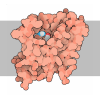[English] 日本語
 Yorodumi
Yorodumi- PDB-8ta3: Cryo-EM structure of the human CLC-2 chloride channel transmembra... -
+ Open data
Open data
- Basic information
Basic information
| Entry | Database: PDB / ID: 8ta3 | |||||||||||||||
|---|---|---|---|---|---|---|---|---|---|---|---|---|---|---|---|---|
| Title | Cryo-EM structure of the human CLC-2 chloride channel transmembrane domain Apo state with resolved N-terminal hairpin | |||||||||||||||
 Components Components | Chloride channel protein 2 | |||||||||||||||
 Keywords Keywords |  TRANSPORT PROTEIN / TRANSPORT PROTEIN /  Chloride / Channel / Inhibitor / Chloride / Channel / Inhibitor /  Protein / Voltage gated Protein / Voltage gated | |||||||||||||||
| Function / homology |  Function and homology information Function and homology informationregulation of aldosterone biosynthetic process / cell differentiation involved in salivary gland development / acinar cell differentiation / voltage-gated chloride channel activity / chloride transport / positive regulation of oligodendrocyte differentiation /  chloride channel complex / lung development / Stimuli-sensing channels / retina development in camera-type eye ...regulation of aldosterone biosynthetic process / cell differentiation involved in salivary gland development / acinar cell differentiation / voltage-gated chloride channel activity / chloride transport / positive regulation of oligodendrocyte differentiation / chloride channel complex / lung development / Stimuli-sensing channels / retina development in camera-type eye ...regulation of aldosterone biosynthetic process / cell differentiation involved in salivary gland development / acinar cell differentiation / voltage-gated chloride channel activity / chloride transport / positive regulation of oligodendrocyte differentiation /  chloride channel complex / lung development / Stimuli-sensing channels / retina development in camera-type eye / chloride channel complex / lung development / Stimuli-sensing channels / retina development in camera-type eye /  perikaryon / perikaryon /  dendrite / dendrite /  plasma membrane plasma membraneSimilarity search - Function | |||||||||||||||
| Biological species |   Homo sapiens (human) Homo sapiens (human) | |||||||||||||||
| Method |  ELECTRON MICROSCOPY / ELECTRON MICROSCOPY /  single particle reconstruction / single particle reconstruction /  cryo EM / Resolution: 2.46 Å cryo EM / Resolution: 2.46 Å | |||||||||||||||
 Authors Authors | Xu, M. / Neelands, T. / Powers, A.S. / Liu, Y. / Miller, S. / Pintilie, G. / Du Bois, J. / Dror, R.O. / Chiu, W. / Maduke, M. | |||||||||||||||
| Funding support |  United States, 4items United States, 4items
| |||||||||||||||
 Citation Citation |  Journal: Elife / Year: 2024 Journal: Elife / Year: 2024Title: CryoEM structures of the human CLC-2 voltage-gated chloride channel reveal a ball-and-chain gating mechanism. Authors: Mengyuan Xu / Torben Neelands / Alexander S Powers / Yan Liu / Steven D Miller / Grigore D Pintilie / J Du Bois / Ron O Dror / Wah Chiu / Merritt Maduke /  Abstract: CLC-2 is a voltage-gated chloride channel that contributes to electrical excitability and ion homeostasis in many different tissues. Among the nine mammalian CLC homologs, CLC-2 is uniquely activated ...CLC-2 is a voltage-gated chloride channel that contributes to electrical excitability and ion homeostasis in many different tissues. Among the nine mammalian CLC homologs, CLC-2 is uniquely activated by hyperpolarization, rather than depolarization, of the plasma membrane. The molecular basis for the divergence in polarity of voltage gating among closely related homologs has been a long-standing mystery, in part because few CLC channel structures are available. Here, we report cryoEM structures of human CLC-2 at 2.46 - 2.76 Å, in the presence and absence of the selective inhibitor AK-42. AK-42 binds within the extracellular entryway of the Cl-permeation pathway, occupying a pocket previously proposed through computational docking studies. In the apo structure, we observed two distinct conformations involving rotation of one of the cytoplasmic C-terminal domains (CTDs). In the absence of CTD rotation, an intracellular N-terminal 15-residue hairpin peptide nestles against the TM domain to physically occlude the Cl-permeation pathway. This peptide is highly conserved among species variants of CLC-2 but is not present in other CLC homologs. Previous studies suggested that the N-terminal domain of CLC-2 influences channel properties via a "ball-and-chain" gating mechanism, but conflicting data cast doubt on such a mechanism, and thus the structure of the N-terminal domain and its interaction with the channel has been uncertain. Through electrophysiological studies of an N-terminal deletion mutant lacking the 15-residue hairpin peptide, we support a model in which the N-terminal hairpin of CLC-2 stabilizes a closed state of the channel by blocking the cytoplasmic Cl-permeation pathway. | |||||||||||||||
| History |
|
- Structure visualization
Structure visualization
| Structure viewer | Molecule:  Molmil Molmil Jmol/JSmol Jmol/JSmol |
|---|
- Downloads & links
Downloads & links
- Download
Download
| PDBx/mmCIF format |  8ta3.cif.gz 8ta3.cif.gz | 336.8 KB | Display |  PDBx/mmCIF format PDBx/mmCIF format |
|---|---|---|---|---|
| PDB format |  pdb8ta3.ent.gz pdb8ta3.ent.gz | 268.7 KB | Display |  PDB format PDB format |
| PDBx/mmJSON format |  8ta3.json.gz 8ta3.json.gz | Tree view |  PDBx/mmJSON format PDBx/mmJSON format | |
| Others |  Other downloads Other downloads |
-Validation report
| Arichive directory |  https://data.pdbj.org/pub/pdb/validation_reports/ta/8ta3 https://data.pdbj.org/pub/pdb/validation_reports/ta/8ta3 ftp://data.pdbj.org/pub/pdb/validation_reports/ta/8ta3 ftp://data.pdbj.org/pub/pdb/validation_reports/ta/8ta3 | HTTPS FTP |
|---|
-Related structure data
| Related structure data |  41127MC 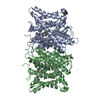 8ta2C 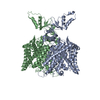 8ta4C 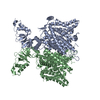 8ta5C 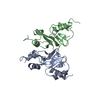 8ta6C C: citing same article ( M: map data used to model this data |
|---|---|
| Similar structure data | Similarity search - Function & homology  F&H Search F&H Search |
- Links
Links
- Assembly
Assembly
| Deposited unit | 
|
|---|---|
| 1 |
|
- Components
Components
| #1: Protein |  / ClC-2 / ClC-2Mass: 95487.641 Da / Num. of mol.: 2 Source method: isolated from a genetically manipulated source Source: (gene. exp.)   Homo sapiens (human) / Gene: CLCN2 / Production host: Homo sapiens (human) / Gene: CLCN2 / Production host:   Homo sapiens (human) / References: UniProt: P51788 Homo sapiens (human) / References: UniProt: P51788#2: Chemical |  Chloride ChlorideHas ligand of interest | N | |
|---|
-Experimental details
-Experiment
| Experiment | Method:  ELECTRON MICROSCOPY ELECTRON MICROSCOPY |
|---|---|
| EM experiment | Aggregation state: PARTICLE / 3D reconstruction method:  single particle reconstruction single particle reconstruction |
- Sample preparation
Sample preparation
| Component | Name: Chloride channel protein 2 / Type: COMPLEX / Entity ID: #1 / Source: RECOMBINANT / Type: COMPLEX / Entity ID: #1 / Source: RECOMBINANT |
|---|---|
| Molecular weight | Experimental value: NO |
| Source (natural) | Organism:   Homo sapiens (human) Homo sapiens (human) |
| Source (recombinant) | Organism:   Homo sapiens (human) Homo sapiens (human) |
| Buffer solution | pH: 7.5 |
| Specimen | Embedding applied: NO / Shadowing applied: NO / Staining applied : NO / Vitrification applied : NO / Vitrification applied : YES : YES |
| Specimen support | Grid material: COPPER / Grid type: Quantifoil R1.2/1.3 |
Vitrification | Cryogen name: ETHANE |
- Electron microscopy imaging
Electron microscopy imaging
| Experimental equipment |  Model: Titan Krios / Image courtesy: FEI Company |
|---|---|
| Microscopy | Model: FEI TITAN KRIOS |
| Electron gun | Electron source : :  FIELD EMISSION GUN / Accelerating voltage: 300 kV / Illumination mode: FLOOD BEAM FIELD EMISSION GUN / Accelerating voltage: 300 kV / Illumination mode: FLOOD BEAM |
| Electron lens | Mode: BRIGHT FIELD Bright-field microscopy / Nominal defocus max: 2000 nm / Nominal defocus min: 1000 nm Bright-field microscopy / Nominal defocus max: 2000 nm / Nominal defocus min: 1000 nm |
| Image recording | Average exposure time: 5.6 sec. / Electron dose: 50 e/Å2 / Film or detector model: FEI FALCON IV (4k x 4k) / Num. of real images: 14300 |
- Processing
Processing
| EM software |
| ||||||||||||||||||||||||||||||||||||||||
|---|---|---|---|---|---|---|---|---|---|---|---|---|---|---|---|---|---|---|---|---|---|---|---|---|---|---|---|---|---|---|---|---|---|---|---|---|---|---|---|---|---|
CTF correction | Type: PHASE FLIPPING AND AMPLITUDE CORRECTION | ||||||||||||||||||||||||||||||||||||||||
| Particle selection | Num. of particles selected: 5214695 | ||||||||||||||||||||||||||||||||||||||||
3D reconstruction | Resolution: 2.46 Å / Resolution method: FSC 0.143 CUT-OFF / Num. of particles: 2415222 / Symmetry type: POINT | ||||||||||||||||||||||||||||||||||||||||
| Atomic model building | Protocol: FLEXIBLE FIT / Space: REAL / Target criteria: Q-score | ||||||||||||||||||||||||||||||||||||||||
| Atomic model building | Accession code: 6qvc / Source name: SwissModel / Type: in silico model |
 Movie
Movie Controller
Controller






 PDBj
PDBj